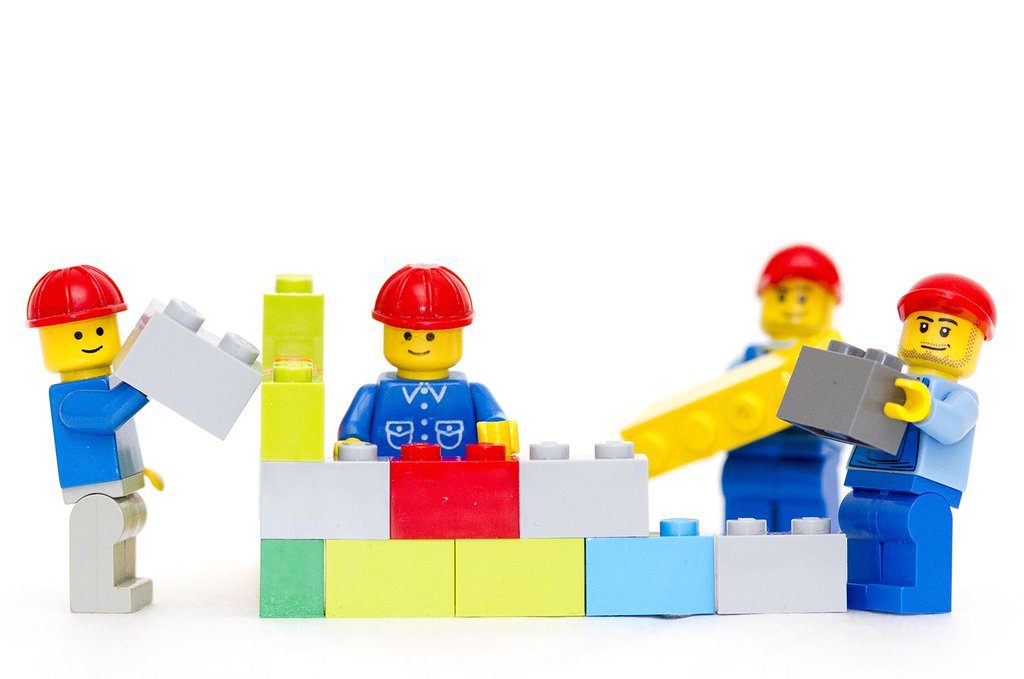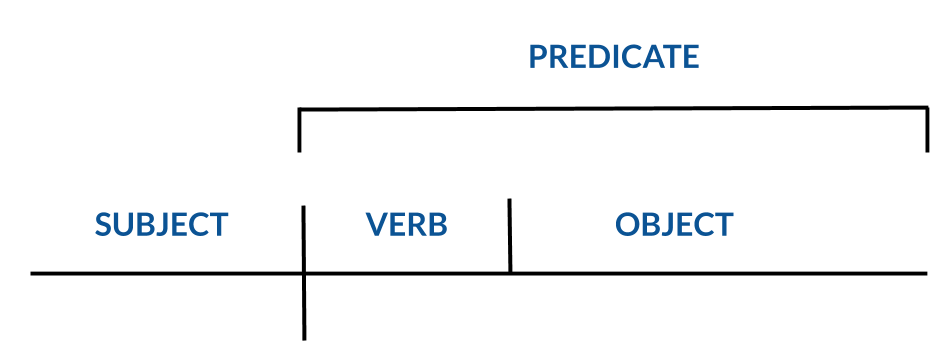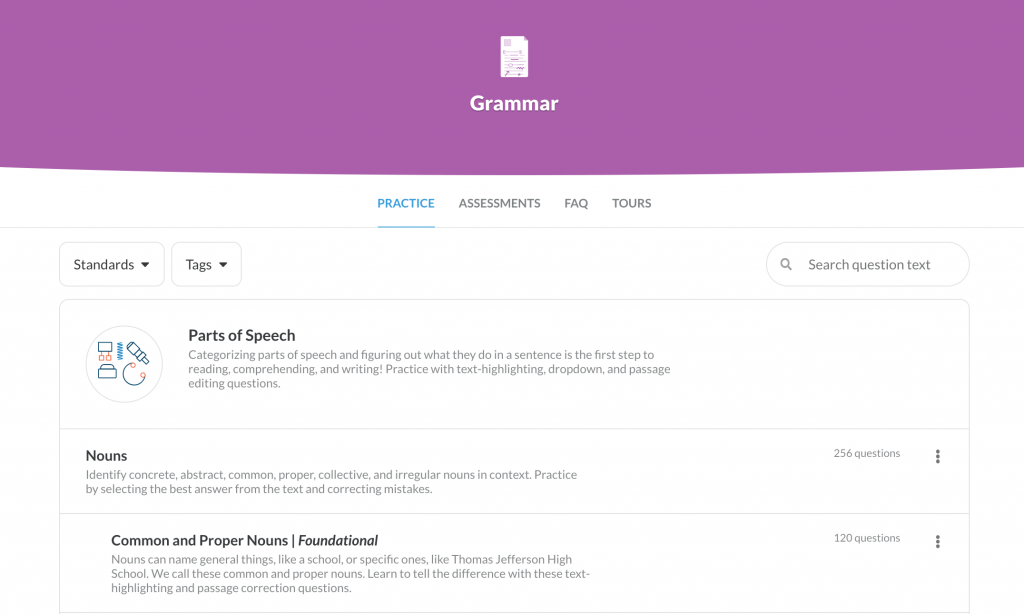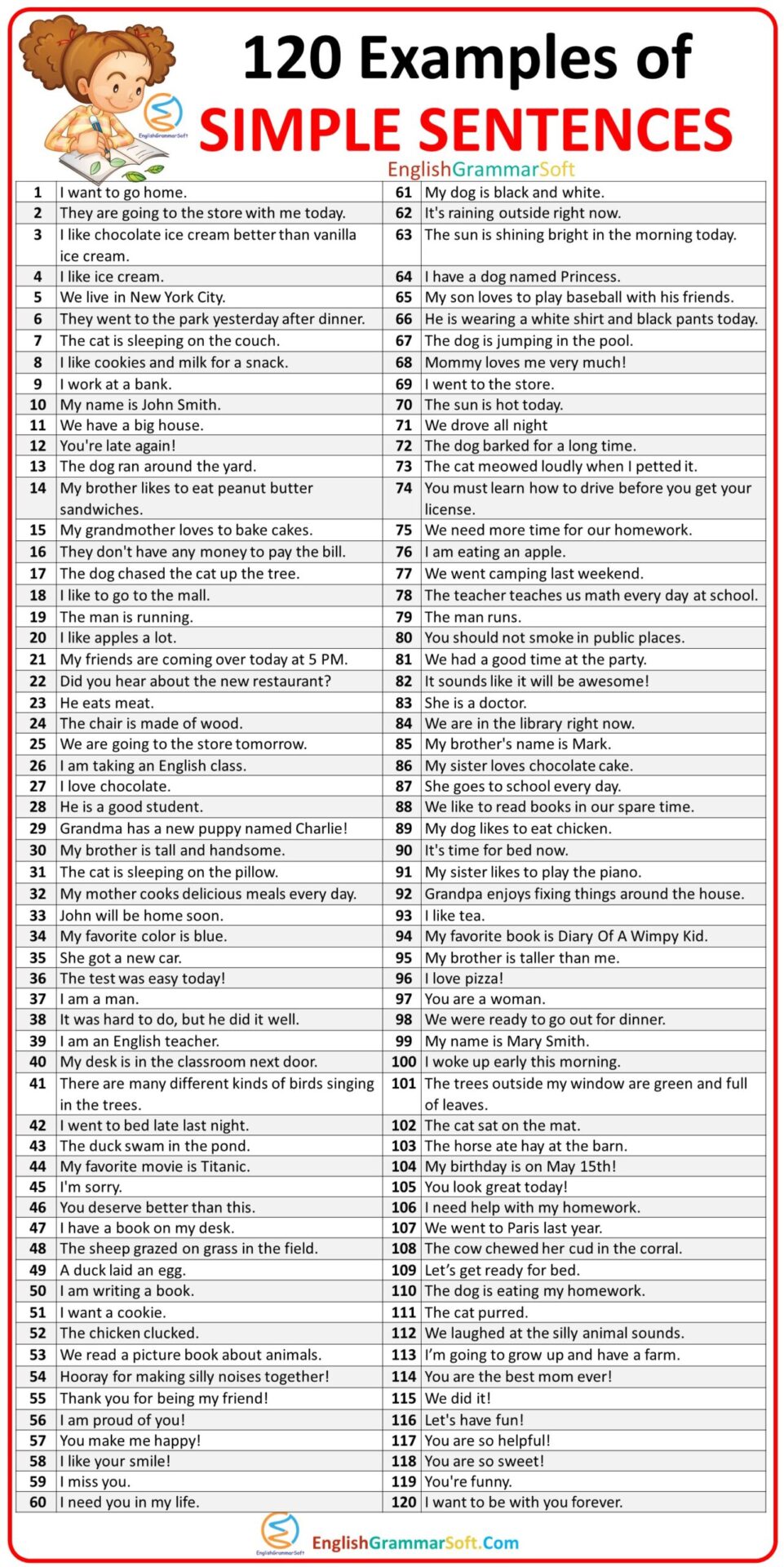
By
Last updated:
April 13, 2022
How to Make Your Own English Sentences with These 18 Easy Forms
By learning some easy English sentences, you are setting yourself up for understanding all English conversation.
Even the most complicated sentences start with a simple structure.
Learn these basic sentence structures, and you will be learning a valuable lesson—no matter what your level of English is.
Contents
- Understanding Parts of Speech
- How to Break Sentences into Sections
- Learning More About Sentence Structure
- 18 Quick Ways to Build Easy English Sentences, with 65+ Examples
-
- Making Statements About the Present
-
- 1. Describing something or someone.
- 2. Stating the location of something or someone.
- 3. Explaining what someone is doing.
- 4. Stating what someone does for a living or a hobby.
- 5. Expressing feelings.
- 6. Making a suggestion.
- Making Statements About the Past
-
- 7. Describing something or someone in the past.
- 8. Stating the location of something or someone in the past.
- 9. Explaining what someone did, or used to do in the past.
- Making Statements About the Future
-
- 10. Stating what someone will do in the future.
- 11. Stating when something will happen.
- Making Negative Statements
-
- 12. Stating what someone is not, or not doing.
- 13. Stating what someone did not do.
- 14. Stating what someone will not do in the future.
- Asking Questions
-
- 15. Asking where someone is.
- 16. Asking what someone is doing.
- 17. Asking about when something will happen.
- 18. Asking who is doing something.
Download:
This blog post is available as a convenient and portable PDF that you
can take anywhere.
Click here to get a copy. (Download)
Understanding Parts of Speech
To understand easy English sentences, you need to break them down into even smaller parts.
Sentences are made up of words. More specifically, they are made up of parts of speech. A part of speech defines what a word does in a sentence.
The parts of speech are:
- Noun: A person, place or thing. Examples: Cat, table, king.
- Pronoun: A word used in place of a noun. Examples: He, she, they.
- Verb: An action word. Examples: Swim, is, write.
- Adjective: A word that modifies (changes) or describes a noun or another adjective. Examples: Beautiful, white, shiny.
- Adverb: A word that modifies or describes a verb. (It shows how something is done.) Examples: Quickly, carefully, brightly.
- Preposition: A word that describes the relationship to a noun. Examples: From, under, until.
- Conjunction: A connecting word. Examples: And, but, although.
If you don’t already know these parts of speech, read that list a few times. These terms will be important later in this post, in your English studies and in whichever English situations you find yourself in, whether with friends, at school or at work!
How to Break Sentences into Sections
So now you have the words you need to form your sentence, and you know what parts of speech they are. Now you need to learn how to combine them. A sentence has a subject (the person, place or thing that the sentence is about) and an action (what the subject is doing). Together, they express a complete thought. Even the shortest complete sentence in the English language follows this rule:
“I am.” (“I” is the subject, “am” is the action!)
Here is another simple sentence:
“I ate.”
Once you have your subject and action, you can start to add more detail. You can add an object (whoever or whatever the action is being done to):
“I ate a hamburger.”
Or you can add a description:
“I ate a delicious hamburger.”
Sometimes you can even add more subjects and actions:
“I ate a delicious hamburger, but my friend only ate some fries.”
When you are trying to understand a sentence, you can use the above knowledge to break it into smaller pieces. You can also use this information to create the most basic sentences.
Learning More About Sentence Structure
In this article, we are only giving you a basic glance of the many different sentence structures in the English language, perfect for anyone learning English for beginners. To learn more about sentence structure, visit one (or all) of these fantastic resources:
- This page has some useful advice for writing excellent sentences, with plenty of examples. The BBC also has a helpful video about English sentence structure.
- Click on any of the sentence structures in this article for a more detailed explanation.
- If you are a visual learner, Grammar Revolution provides a visual guide to different types of sentence structure.
- Tired of all the reading? Watch an English video instead! You’ll hear how native speakers build sentences naturally. FluentU is the perfect tool for this.
Okay, now you are ready to move on to building sentences!
Before you begin, there are two things you should know about this guide:
1. Whenever we use [noun], you can replace it with a [pronoun]. For example, you can say “Sam is tired,” or you can say “He is tired.” Both are correct.
2. Whenever we use “is,” you will need to replace it with the correct form of “to be.” Choose the right form based on this list for the present tense:
- I am.
- He / she / it is.
- You / they / we are.
And this list for the past tense:
- I / he / she / it was.
- You / they / we were.
That’s all! Now you are ready to begin.
Making Statements About the Present
1. Describing something or someone.
Form: [Noun] is [adjective].
Notes: If the noun you are using is not a pronoun, the name of a place or the name of a person, add the word “the” (or “this,” or “that”) before it.
Examples:
- The flower is red.
- You are wonderful.
- The Empire State Building is tall.
2. Stating the location of something or someone.
Form: [Noun] is [preposition] [location].
Notes: To state the location of something or someone, a preposition is usually necessary. Choose the correct preposition to give the right information. You can also say someone was “here” or “over there.” Since these terms are relative (their meaning depends on your own location), you do not need to add the final “location.”
Once again, nouns that are not names of people or places get “the” added before them.
Examples:
- The cat is under the bed.
- Charlie is next to Anne.
- He is on the train.
- The dog is here.
- The men are over there.
3. Explaining what someone is doing.
Form: [Noun] is [verb -ing].
Notes: The “-ing” form of a verb means an action is taking place right now. Use this form when talking about an action that has not ended yet.
Examples:
- He is reading.
- The cat is napping.
- Kate is singing.
4. Stating what someone does for a living or a hobby.
Form: [Noun] [verb -s].
Notes: Using this structure implies the subject of your sentence does the action regularly (like a hobby, or a job), even if they are not necessarily doing it right now.
Examples:
- He reads.
- The cat naps.
- Kate sings.
5. Expressing feelings.
Form: [Noun] [feeling verb -s] [noun]. / [Noun] [feeling verb -s] [to verb / verb -ing].
Notes: Feeling verbs are verbs like “love,” “like” or “hate.” You can love or hate an object, or an action. When you describe someone’s feelings about an action, you can use either the “to verb” or “verb -ing” forms. In most cases, both are correct! You can also use this form to describe needs and wants, but remember that in that case, the “verb -ing” form cannot be used. For example, you don’t “need sleeping.” You “need to sleep,” or just “need sleep.”
Examples:
- I love sunshine.
- The elephant likes painting.
- Tom hates his job.
- I need to eat.
- I want food.
- She wants to sleep.
- She needs sleep.
6. Making a suggestion.
Form: Let’s [verb]. / Please [verb].
Notes: To suggest an action that you will also take part in, use the first structure. To politely ask someone to do something, use the second one.
Examples:
- Let’s eat.
- Please eat.
- Please move. (Please note: This might be grammatically correct, but it is actually not very polite! The polite way to ask someone to move is to say “excuse me.”)
Making Statements About the Past
7. Describing something or someone in the past.
Form: [Noun] was [adjective].
Notes: You describe someone in the past tense almost the same exact way as in the present—just change the “is” to “was.” Using this structure suggests that either the description is no longer accurate, or that the description is for a specific moment.
Examples:
- The flower was red. (…It is not red anymore.)
- You were wonderful. (…You played the violin so well in the concert.)
- The Empire State Building was tall. (…Until the giant apes tore it down.)
8. Stating the location of something or someone in the past.
Form: [Noun] was [preposition] [location].
Notes: As with a description, describing a location in the past and the present is very similar. The rules remain the same; only the verb tense changes. Remember, again, that using this form means the location has changed, or that the statement was only true for a specific time period in the past.
Examples:
- The cat was under the bed. (…But then it ran away.)
- Charlie was next to Anne. (…Then he went behind her.)
- He was on the train. (…That is how he knew the train was going to be late.)
- The dog was here. (…But then its owner took it away.)
- The men were over there. (…Until they finished their job and went home.)
9. Explaining what someone did, or used to do in the past.
Form: [Noun] was [verb -ing]. / [Noun] [verb -ed].
Notes: There is a slight difference between the “verb -ed” form of an action, and the “was verb -ing” form. Using the “verb -ed” form describes something that has finished happening. Using the “-ing” form of a verb describes something that was happening during a specific period of time in the past.
Another form you can use is: [Noun] used [to verb]. This form is used for any kind of action that someone used to do in the past, but has since stopped doing.
All these forms can be used with feeling verbs, as well! Just add the “noun” or “verb -ing” after the feeling verb for a complete sentence.
Examples:
- The cat napped. (…That’s why he is so happy now.)
- Kate sang. (…The concert was wonderful.)
- He was reading. (…That is why he did not hear the doorbell ring.)
- The Statue of Liberty used to shine. (…But being in the salty water all those years has made it green.)
- I used to love shrimp. (…But then I learned that I am allergic to it.)
- Sally hated swimming. (…She had to do it every day in school.)
Making Statements About the Future
10. Stating what someone will do in the future.
Form: [Noun] is going to [verb]. / [Noun] will [verb].
Notes: The great thing about the future tense is that you don’t need to remember any verb forms! To turn a sentence into the future tense, just add the words “is going to” or “will” before the verb. Using this structure without any additional details means you will be doing the action very soon.
Examples:
- I am going to dance.
- We are going to eat.
- The baby is going to sleep.
11. Stating when something will happen.
Form: [Noun] will [verb] [preposition] [time]. / [Noun] is going to [verb] [time adverb].
Notes: Use this structure to talk about things that will happen in the future. When you use a specific time, a preposition is needed. Use “at” when stating a clock time, and “on” when stating a day or date. Use “in” when stating a year, month or another time frame (like “a couple of years” or “two minutes”). When you use a time adverb like today, tomorrow or yesterday, you don’t need a preposition.
Examples:
- The train will leave at 5:00 AM.
- I will visit my parents in October.
- Anthony is going to dance tomorrow.
Making Negative Statements
12. Stating what someone is not, or not doing.
Form: [Noun] is not [adjective / verb-ing].
Notes: Changing a sentence into a negative one is as easy as adding the word “not.”
Examples:
- The flower is not red. (…It is white.)
- You are not wonderful. (…That’s not very nice!)
- The Empire State Building is not tall. (…We never said the sentence has to be true!)
- Kate is not singing. (…Why did she stop?)
13. Stating what someone did not do.
Form: [Noun] did not [verb]. / [Noun] was not [verb -ing].
Notes: Remember the rules from before. Using the first form above puts the focus on the action (in this case, saying it did not happen at all). “Verb -ing” puts the focus on the time the action took place (saying it was not happening at a specific moment).
Examples:
- I did not sleep. (…I stayed awake all night.)
- I was not sleeping. (…While the teacher gave her lesson.)
- The customer did not pay. (…At all. How terrible!)
14. Stating what someone will not do in the future.
Form: [Noun] is not going to [verb]. / [Noun] will not [verb].
Notes: Changing the future tense into a negative sentence is just as easy. Just add “not” before the verb.
Examples:
- I am not going to eat. (…I will not eat green eggs and ham!)
- Sam will not dance. (…He has ants in his pants.)
- The cat will not nap. (…He is going to eat first.)
Asking Questions
15. Asking where someone is.
Form: Where is [noun]?
Notes: You can also use this form to ask about places, things and any other kind of noun you might be trying to find.
Examples:
- Where is the dog?
- Where is George?
- Where is the bathroom?
16. Asking what someone is doing.
Form: What is [noun] doing?
Notes: The noun in this case should be a living thing. (Generally, non-living objects don’t do much!)
Examples:
- What is that dog doing?
- What is Sal doing?
- What is the baby doing?
17. Asking about when something will happen.
Form: When will [noun] [verb]?
Notes: This is a useful sentence structure to know when you want to find out about events in the future.
Examples:
- When will the train leave?
- When will Fran visit?
- When will your mom call?
18. Asking who is doing something.
Form: Who is [verb -ing]? / Who is [verb -ing] [noun]?
Notes: This structure is a bit different. It can be used to refer to the present, and to the near future tenses. Use it to find out who is doing a certain action (for example, if you hear a trumpet and want to know who is playing it). Or, you can use it to find out who will be doing an action in the near future—for example, if you are going on a trip and want to know who will drive the car.
If the action is being done to something, don’t forget to add that something in for a complete thought!
Examples:
- Who is playing the trumpet?
- Who is driving?
- Who is cooking? (…It smells great!)
The easy sentences you learned above are just the beginning.
You have the first Legos in place.
Now go build a castle!
Download:
This blog post is available as a convenient and portable PDF that you
can take anywhere.
Click here to get a copy. (Download)
1. What is a Simple Sentence?
A simple sentence is the most basic sentence that we have in English. It has just one independent clause, which means only one subject and one predicate. A simple sentence is also the shortest possible sentence; it can have as little as two words!
Overall, a simple sentence is exactly what it sounds like—simple!
A simple sentence can be very short, but some are long too, so long as they only have one subject-verb combination. Here, the subjects are orange and the verbs are green.
- I ate.
- I ate dinner.
- I ate dinner with my brother and sister.
- Last night, I ate dinner at a restaurant with my brother and sister.
As you can see, even though some of these sentences are long, each only has one subject and one verb (one clause).
3. Parts of Simple Sentences
All sentences have one main important part: an independent clause. Sometimes, they also include other words, like objects and/or modifiers.
a. Independent Clause
An independent clause has a subject and a predicate and makes sense on its own as a complete sentence. In fact, an independent clause itself is a simple sentence! Here are a few:
- The cat ate.
- He ate ice cream.
- He went to the beach.
- The wolf ate steak at the zoo.
So, you can see that all of the clauses above work as sentences. All sentences have an independent clause, but all simple sentences have ONE independent clause.
B. Objects
An object is the word affected by the verb or preposition in a sentence. Objects are usually nouns or pronouns that answer questions like “who,” “what,” “where,” and “when?” Here, the objects are purple.
- The dog ate bacon. What did the dog eat?
- The dog ate bacon at the park. Where did he eat it?
- I took my dog to the park. Who did you take there?
- We went to the park yesterday. When did you go?
So, you can see that the highlighted objects answer the questions above. They make the sentences more informational than they would be without objects.
c. Modifiers
A modifier is an adjective or adverb that “modifies” other words in a sentence to make it more descriptive. They help give a clearer idea about the things in the sentence. Here, the modifiers are gray. Let’s start with a simple sentence:
The panda ate corn.
Now, let’s add modifiers:
The fat panda quickly ate the buttery corn.
Modifiers make the sentence more detailed. We now know that the panda was fat, that he ate quickly, and that the corn was buttery! Modifiers can make sentences much more interesting.
4. Types of Simple Sentences
There aren’t exactly different “types” of simple sentences, but they can be written in different ways. As mentioned, sometimes they are very short, or sometimes they include modifiers or objects that make them longer.
a. Simple Sentence with ONLY a Subject and a Verb
As mentioned, simple sentences are the shortest possible complete sentences. You can have a simple sentence with only a simple subject and a predicate, using only two or three words, like this:
- I see.
- He ran.
- We looked.
- They cooked.
- The dog ate.
- The baby cried.
Though only two or three words, these are all independent clauses, so they work on their own as complete sentences!
b. Simple Sentence with other Objects or Modifiers
Not all simple sentences are short. So long as it only has one subject and one predicate, a simple sentence can actually be pretty long. Take a look at the extra words in these examples:
- I see you behind the cotton candy machine!
- He ran to the fair as fast as possible.
- We ate buttery corn at the famous farmer’s market.
- They prepared cotton candy in an old-fashioned machine.
So, a simple sentence can use lots of modifiers and objects to add details, while at the same time only describing one subject doing one thing.
5. How to Avoid Mistakes
The most important thing to remember about simple sentences is that they never have more than one subject or more than one predicate. In other words, there is only one subject doing one thing. A simple sentence CAN have a compound subject (two people using the same verb), but that’s still just one subject.
- (WRONG) Maria went to the market and bought an apple. One subject, two verbs
- (WRONG) Sandy drove to the market and the dog went with her. Two subjects, two verbs
- (CORRECT) Jose went to the market. One subject, one verb
- (CORRECT) Maria and Jose went to the market. One compound subject, one verb
When you start adding more independent or dependent clauses to a sentence, you get a compound, complex, or compound-complex sentence. BUT, a simple sentence is just simple—one subject, one predicate.
English is a complicated language with so many rules that it can be difficult for beginners to know where to start. In this blog post, we will give you a few tips on how to make a sentence in English. By following these simple steps, you will be able to create correctly-formed sentences and improve your understanding of the language. So, let’s get started!
Making a sentences is very simple, you just have to followed this 5 steps guide to make a perfect sentences. Let us first discuss about some important terms:
What is a Sentences?
A sentence is a phrase which having a subject and predicate. It is also called as a complete thoughts. A sentence also has a full stop. To use a sentences it must have more than one words. Sentence is a group of words that have some sense or meaning.
It is not a difficult task to make a sentences. A sentence is the most important part of any compositions or writings. It shows that how well you can arrange your words and can express your thoughts. It is also the most important items in English Grammar.
Types of Sentences
There are three types of sentences:
a) Simple sentence:
It’s a sentence which contains one clause. It is also called as independent clause.
- I like to watch TV.
It is a simple sentence because it has one subject(I) and predicate (like to watch TV).
b) Compound sentence:
A compound sentence is a sentences which contains two or more independent clause.
- I like to watch TV and my favorite programs are comedy shows.
This is a compound sentences because it has more than one independent clause.
c) Complex Sentence:
At first a complex sentence seems as a compound sentence from outside, but from inside it has at least one dependent clause.
- When I go home, I watch my favorite TV shows.
This is a complex sentence because it has one independent clause and one dependent clause “When I go home”
Structure of a Sentence
A sentence must have a subject and predicate. We can make a long sentences or short sentences as we like to express our feelings and thoughts. But according to English Composition, a sentence must have more than one word.
Subject?
Subject is the part of sentence which describes who or what about in the sentence. For example; “I”, “the dog”, “the cats”. A Subject is a word or a group of words that tells about who or what the sentence is about. The subject is one of the most important part in making a sentences.
Predicate?
Predicate is the part of sentence which tells about what has been done in the sentence. For example; “I am going”, “she is going”, “my dog run fast”. The predicate make a full sentence.
5 Steps to Make a Perfect Sentence
1) Convert Ideas into words:
The first step is to turn your idea into words. It is impossible to make a sentence without the right words so you must know what you want to say clearly inside your mind. Using an unknown or random word will reduce its effect and changing the feeling of the sentence so it would be meaningless.
2) Write down ideas with essential key words:
In this step, you have to write down the most essential key words. It is not necessary to use many words so if one word is enough for your sentence then it would be better. Also do not forget to use a brief and simple way of writing so it will be easy to read and understand by other people.
3) Create a comma to create two sentences:
After writing down the key words, you must use a comma so it will be easier for readers to understand the meaning of your sentence. A period is not recommend because it would impact your sentence in negative way. The purpose of using a comma is turn one sentence into two with different contents.
4) Place a command to complete your sentences:
In this step, you have to put a command from the key words that you have written. This is the last step but not least because it would create an effect on your sentence. A correct order of words and commands will lead your sentence into perfect one which is easy to read by other people.
5) Connecting parts of speech to complete your sentences:
The last step is to connect the key words and commands to form a sentence. It would be hard for readers if your sentences are not connected so it must be connected carefully. A right connecting words should be used, otherwise it would lead your sentence into wrong direction.
Now you know how to make a sentence in 5 steps, try it now!
Common FAQs!
What are Parts of a Sentences?
Parts of sentences are called sentence elements. There are eight parts of sentence which are found in every sentence. There are four parts of a sentence which are mandatory and four other parts that would be chosen as the writer like to choose them.
a) Four Mandatory Parts of a Sentences:
- Subject
- Predicate
- Command
- Object (optional)
b) Four Choices of Parts of a Sentences:
- Adverb
- Adjective
- Appositive
- Conjunction (optional)
Do verbs create sentences?
Yes, verbs can create sentences and it is one of the basic parts of speech to make a sentence. Verbs are used to show action so if you want to say “I walked” then you must use a verb “walked”.
Do prepositions create sentences?
Prepositions are not commonly used to create sentences but it can help to create one. Prepositions are used to show purpose, location and direction so it is a part of speech that you have to remember when making a sentence.
Do adjectives create sentences?
Adjectives are one of the most important parts of speech which can create sentences by itself. Adjectives are used to describe nouns, pronouns and other parts of speech. Without adjectives, your sentences would be meaningless.
Can a sentence have two verbs?
Yes, it is possible for a sentence to have two verbs. Using two verbs in one sentence will create different meaning so you should choose the right verb that can be separated into two sentences.
About Author
Simi
Meet Simeron Khan, an experienced ESL teacher with a passion for guiding students towards fluency in English. With a knack for making even the most complex grammar rules accessible and enjoyable, Simeron has helped countless learners achieve their language goals.
Do you remember the first time you learned how to write a sentence? Most of us are taught how to put three words together to make sentences in kindergarten: I like dogs. She eats cookies. Games are fun! Sound familiar? These three-word sentences are one of the most basic types of simple sentences, and they serve as a foundation to forming more complex sentences. However, simple sentences are not always as simple as three-word sentences.
In this post we’ll review what simple sentences are, the parts of a simple sentence, and different ways to create simple sentences.
Once you’re feeling confident, test yourself with a post-assessment quiz and practice with our high quality, standards-aligned questions here.
The Basics of Simple Sentences

What are Simple Sentences?
A simple sentence is a sentence containing only one clause, or more specifically, an independent clause, with a subject and a predicate.
A simple sentence is typically made up of a subject, verb, and object, or SVO, and creates a complete thought; however, since a simple predicate is a verb or verb phrase only, a simple sentence can also be made up of only a subject and verb (SV).

Subject + Verb + Object (SVO)
- Jessie ate dinner.
Subject + Verb (SV)
- Jessie ate.
Both of these examples are grammatically correct simple sentences, but including an object helps to clarify the full idea of the sentence.
Despite their name, simple sentences can include things that are not so simple. Let’s review the use of modifiers, compound subjects, and compound verbs/predicates in simple sentences.
Modifiers in Simple Sentences

Modifiers are words or phrases that can be included in simple sentences to add more detail. Let’s see how we can modify the simple sentence used above:
- Jessie ate dinner.
Adding Articles/Adjectives
- The hungry Jessie ate a large dinner.
Adding Adverbs
- The hungry Jessie quickly ate a very large dinner.
Adding a Prepositional Phrase
- The hungry Jessie quickly ate a very large dinner after a long day at work.
All of these examples still qualify as simple sentences, because they are all independent clauses that convey a complete thought.
Pro Tip: Ask yourself how the sentence is changed as a result of a modifier.
Compound Subjects in Simple Sentences
Compound subjects are two or more nouns or pronouns sharing the same verb. They are joined using coordinate or correlative conjunctions.
Compound Subjects Using Coordinate Conjunctions
- Jessie and Jade ate dinner.
- Jessie or Jade ate dinner.
- Jessie, Jade, and Titus ate dinner.
Compound Subjects Using Correlative Conjunctions
- Both Jessie and Jade ate dinner.
- Neither Jessie nor Jade ate dinner.
Even with two or more simple subjects, these examples are independent clauses conveying a complete thought, so they are still simple sentences.
Compound Verbs/Predicates in Simple Sentences

Compound verbs, or compound predicates, are two or more verbs/predicates that share the same subject. This may be written as simply as a subject performing multiple verbs (simple predicates) or, more elaborately, as a subject performing multiple complete predicates. The compound verbs/predicates are joined by a conjunction.
Compound Verbs/Simple Predicates
- Jessie cooked and ate dinner.
- Jessie rinsed and washed the dishes.
Compound Predicates
- Jessie ate dinner and washed the dishes.
- Jessie cooked dinner and rinsed the dishes
Again, these examples are all independent clauses conveying a complete thought. So even with multiple verbs, a sentence can be a simple sentence.
Return to the Table of Contents
Tips for Using and Identifying Simple Sentences
Tip #1: Subject + Verb + Object (SVO) Simple Sentences Can be Arranged in Different Ways.
While a simple sentence is typically expected to contain a subject, verb, and object, this does not always mean that the subject will be the first thing we see in a sentence. When we place parts of the predicate at the beginning of the sentence or ask a question, the standard SVO arrangement of a simple sentence will vary.
Placing a Part of the Predicate Before the Subject
When the predicate, or verb + object portion of the sentence contains a prepositional phrase or adverb, they can appear at the beginning of the sentence followed by a comma. Check out the following examples to see sentences in both their standard forms and rearranged forms:
Prepositional Phrase:
- We completed our homework after school.
- After school, we completed our homework.
Adverb:
- I ran quickly to the store.
- Quickly, I ran to the store.
Asking a Question
Sentences that ask a question are called interrogative sentences, and they are often simple sentences. Some questions start with the main verb or part of the verb phrase. Look at the examples below to see the placement of the verb in both a question and the statement form of the question:
- Will it rain tomorrow?
- It will rain tomorrow.
- Has the race been postponed?
- The race has been postponed.
- Were you sick today?
- You were sick today.
Tip #2: Avoid using too many basic simple sentences in your writing.
Remember, basic simple sentences are the first type of sentence we learn how to write. So it’s probably safe to assume that filling our writing with three or four word sentences is not the best idea. Too many simple sentences close together can sound choppy and disconnected. Always revise your work to see where simple sentences can be edited to create more sophisticated writing.
Combine Simple Sentences
If you have a string of very basic simple sentences in your writing, you can probably combine some of those sentences into compound sentences.
Choppy:
- He loves baseball. He first played little league baseball. He joined the baseball team in middle school.
Revised:
- He loves baseball and played little league before joining the baseball team in middle school.
Tip #3: Add more detail.
There’s nothing wrong with using simple sentences in your writing, but you can (and should) use modifiers to enhance simple sentences when possible.
Basic Simple Sentence:
- I visited Chichén Itzá.
Revised:
- On my vacation to Mexico, I visited the ancient Mayan ruins of Chichén Itzá.
Return to the Table of Contents
Applying the Basics: Simple Sentences Review & Practice
Now that you understand what simple sentences are, and how to use them properly in your writing, let’s practice identifying them. Remember, a simple sentence is a sentence that contains one independent clause, or one complete thought.
Simple Sentences Exercises & Review
Complete the quick exercise below to assess your mastery of simple sentences.
Determine if the sentence is a simple sentence or not.
1. I finally received my passport for our trip overseas.
- Simple Sentence
2. Last week, she told the funniest joke in the middle of the meeting.
- Simple Sentence
3. Tim went to the store, and he bought a new laptop for school.
- Not a Simple Sentence
4. Julie and Paige went to the amusement park and rode a rollercoaster.
- Simple Sentence
5. I was exhausted after working all day.
- Not a Simple Sentence
For additional practice, check out the Simple Sentences content on Albert.
Return to the Table of Contents
Try for Yourself: Simple Sentences Quiz

Feeling confident in your understanding of Simple Sentences?
Take this short quiz to see what you’ve learned:
1. Can a simple sentence have more than one subject?
- Answer: Yes
- Correct Explanation: That’s right! A simple sentence can have more than one subject, or a compound subject, if they are sharing the same verb. The subjects are joined using coordinate or correlative conjunctions.
- Incorrect Explanation: Sorry, that’s not right. A simple sentence can have more than one subject, or a compound subject, if they are sharing the same verb. The subjects are joined using coordinate or correlative conjunctions.
2. Can a simple sentence be a single dependent clause?
- Answer: No
- Correct Explanation: That’s right! A simple sentence must be a single independent clause in order to be a simple sentence. It is a complete thought and can stand alone. A dependent clause cannot stand alone as a complete thought.
- Incorrect Explanation: Sorry, that’s not right. A dependent clause cannot stand alone as a complete thought. A simple sentence must be a single independent clause in order to be a simple sentence. It is a complete thought and can stand alone.
3. Can a simple sentence have more than one verb?
- Answer: Yes
- Correct Explanation: That’s right! A simple sentence can have more than one verb (compound verb/simple predicate) or more than one complete predicate (compound predicate) if they share the same subject. They are combined using a conjunction.
- Incorrect Explanation: Sorry, that’s not right. A simple sentence can have more than one verb (compound verb/simple predicate) or more than one complete predicate (compound predicate) if they share the same subject. They are combined using a conjunction.
4. Does a simple sentence always start with the subject?
- Answer: No
- Correct Explanation: That’s right! A simple sentence can start with part of the predicate. This might be a prepositional phrase, and adverb, or a question.
- Incorrect Explanation: Sorry, that’s not right. A simple sentence can start with part of the predicate. This might be a prepositional phrase, and adverb, or a question.
5. Is the following example a simple sentence?
After eating breakfast, Hayley went to dance practice, and she prepared for her performance.
- Answer: No
- Correct Explanation: That’s right! A simple sentence can have more than one predicate when that predicate shares the same subject. In this sentence, there are two independent clauses: After eating breakfast, Hayley went to dance practice. She prepared for her performance.
- Incorrect Explanation: Sorry, that’s not right. A simple sentence can have more than one predicate when that predicate shares the same subject. In this sentence, there are two independent clauses: After eating breakfast, Hayley went to dance practice. She prepared for her performance.
6. Is the following example a simple sentence?
Jim and Amy thoroughly cleared out the basement and hired contractors for a remodel.
- Answer: Yes
- Correct Explanation: That’s right! A simple sentence can have compound subjects and compound predicates as long as they form one complete thought. The subjects share the predicates, and the predicates share the subjects. In this case, the compound subject “Jim and Amy” share the compound predicates “thoroughly cleared out the basement” and “hired contractors for a remodel.”
- Incorrect Explanation: Sorry, that’s not right. A simple sentence can have compound subjects and compound predicates as long as they form one complete thought. The subjects share the predicates, and the predicates share the subjects. In this case, the compound subject “Jim and Amy” share the compound predicates “thoroughly cleared out the basement” and “hired contractors for a remodel.”
For additional practice with simple sentences, check out our completely free practice on Albert.io: Simple Sentences.
Return to the Table of Contents
Teacher’s Corner for Simple Sentences
While it’s true that simple sentences are a foundational grammar skill, the Common Core English Language Progressive Skills Chart shows that even elementary-level skills “require continued attention in higher grades as they are applied to increasingly sophisticated writing and speaking.”
For specific standards addressing simple sentences, check out the Common Core State Standards site!
Albert’s grammar course is 100% free, and the Simple Sentences practices can be used for much more than homework!
Our assessments can be used as pre-and post-tests to measure student progress. Our pre-made quizzes can be used as bell-ringers, exit tickets, and more!
In addition to our pre-made assessments, you can also use our assignments feature to create your own quizzes and assessments.
Summary on Simple Sentences
Simple sentences are sentences containing one independent clause, with a subject and a predicate.
Modifiers, compound subjects, and compound verbs/predicates can be used in simple sentences.
The standard arrangement of a simple sentence is subject + verb + object, or SVO order. This can vary by arranging parts of the predicate before the subject.
Practice makes perfect! Use our Simple Sentences practice on Albert’s completely free grammar course!
Need help preparing for your Grammar exam?

Albert has hundreds of grammar practice questions with detailed explanations to help you master concepts.
Simple sentences are the most basic kind of sentence. They contain only one clause, a group of words containing a subject, verb and object.
How to form the simple sentences? See the below examples:
- Dogs bark. (Subject + verb)
- Cats meow. (Subject + verb)
- I can sing very well! (Subject + infinitive)
- My friend is running fast! (Subject + present participle)
What is a simple sentence and its types?
A simple sentence is a basic sentence that contains a subject and a verb. The subject is the person or thing doing something, and the verb shows the action taken. Simple sentences can be made longer by adding more information to them.
There are many different types of simple sentences, but some of the most common include:
- Declarative sentences state facts or opinions. Example: “The sun rises in the east.”
- Exclamatory sentences express strong feelings or emotions. Example: “Wow!”
- Imperative sentences give commands or directions. Example: “Close the door.”
- Interrogative sentences ask questions. Example: “Do you like tea?”
- Informational sentences provide information about things. Example: “This is a pen.”
Examples of Simple Sentences
- I want to go home.
- My dog is black and white.
- They are going to the store with me today.
- It’s raining outside right now.
- I like chocolate ice cream better than vanilla ice cream.
- The sun is shining bright in the morning today.
- I like ice cream.
- I have a dog named Princess.
- We live in New York City.
- He is wearing a white shirt and black pants today.
- They went to the park yesterday after dinner.
- My son loves to play baseball with his friends.
- The cat is sleeping on the couch.
- The dog is jumping in the pool.
- I like cookies and milk for a snack.
- Mommy loves me very much!
- I work at a bank.
- I went to the store.
- My name is John Smith.
- The sun is hot today.
- We have a big house.
- We drove all night
- You’re late again!
- The dog barked for a long time.
- The dog ran around the yard.
- The cat meowed loudly when I petted it.
- My brother likes to eat peanut butter sandwiches.
- I like to go to the mall.
- My grandmother loves to bake cakes.
- Grandpa enjoys fixing things around the house
- They don’t have any money to pay the bill.
- I am eating an apple.
- The dog chased the cat up the tree.
- We went camping last weekend.
- You must learn how to drive before you get your license.
- We need more time for our homework.
- The man is running.
- The man runs.
- I like apples a lot.
- You should not smoke in public places.
- My friends are coming over today at 5 PM.
- We had a good time at the party.
- Did you hear about the new restaurant?
- It sounds like it will be awesome!
- He eats meat.
- She is a doctor.
- The chair is made of wood.
- We are in the library right now.
- We are going to the store tomorrow.
- My brother’s name is Mark.
- I am taking an English class.
- My sister loves chocolate cake.
- I love chocolate.
- She goes to school every day.
- He is a good student.
- We like to read books in our spare time.
- The teacher teaches us math every day at school.
- My dog likes to eat chicken.
- My brother is tall and handsome.
- It’s time for bed now.
- The cat is sleeping on the pillow.
- My sister likes to play the piano.
- My mother cooks delicious meals every day.
- Grandma has a new puppy named Charlie!
- John will be home soon.
- I like tea.
- My favorite color is blue.
- My favorite book is Diary Of A Wimpy Kid.
- She got a new car.
- My brother is taller than me.
- The test was easy today!
- I love pizza!
- I am a man.
- You are a woman.
- It was hard to do, but he did it well.
- We were ready to go out for dinner.
- I am an English teacher.
- My name is Mary Smith.
- My desk is in the classroom next door.
- The trees outside my window are green and full of leaves.
- There are many different kinds of birds singing in the trees.
- I woke up early this morning.
- I went to bed late last night.
- The cat sat on the mat.
- The duck swam in the pond.
- The horse ate hay at the barn.
- My favorite movie is Titanic.
- My birthday is on May 15th!
- I’m sorry.
- You look great today!
- You deserve better than this.
- I need help with my homework.
- I have a book on my desk.
- We went to Paris last year.
- The sheep grazed on grass in the field.
- The cow chewed her cud in the corral.
- A duck laid an egg.
- Let’s get ready for bed.
- I am writing a book.
- The dog is eating my homework.
- I want a cookie.
- The cat purred.
- The chicken clucked.
- We laughed at the silly animal sounds.
- We read a picture book about animals.
- I’m going to grow up and have a farm.
- Hooray for making silly noises together!
- You are the best mom ever!
- Thank you for being my friend!
- We did it!
- I am proud of you!
- Let’s have fun!
- You make me happy!
- You are so helpful!
- I like your smile!
- You are so sweet!
- I miss you.
- You’re funny.
- I need you in my life.
- I want to be with you forever.

You may also like
- No Sooner Than Sentences (31 Examples)
- Examples with Neither Nor (50 Sentences)
- Sentences with Commas (50 Examples)
- Sentences With Semicolons (;) 50 Examples
- Sentences with Apostrophes (Possession & Contraction)
- Example Sentences with Yet Conjunction
- Sentences with Either – or
- Sentences with Furthermore
- RUN INTO Sentences
- Sentences with Too
- Make Sentences with Too Many
- Make Sentences with Too Much
- Sentences with Write
- Sentences with Juxtapose
- Sentences with Then and Than
- 50 Example Sentences with However
- 31 Example Sentences with Kinsmen
- Sentences with make
- Do Does Did Sentences (50 Examples)
- Has Have Had use in sentences | 50 Examples
- Was Were Sentences | 50 Examples
- There is – There are Sentences | 50 Examples
- Is am are sentences in English (50 Examples)



